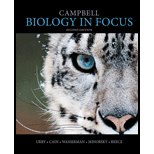
Campbell Biology in Focus (2nd Edition)
2nd Edition
ISBN: 9780321962751
Author: Lisa A. Urry, Michael L. Cain, Steven A. Wasserman, Peter V. Minorsky, Jane B. Reece
Publisher: PEARSON
expand_more
expand_more
format_list_bulleted
Question
Chapter 29.6, Problem 1CC
Summary Introduction
To suggest:
A mechanism, by which activation of proton pumpsby fusicoccinleads to severe wilting.
Introduction:
The plants acquirethe carbon dioxide by the opening of stomata. The carbon dioxide enters the plant cells, but the water is lost during the opening of stomata. The entry of carbon dioxide and loss of water is regulated by guard cells.
Expert Solution & Answer
Want to see the full answer?
Check out a sample textbook solution
Students have asked these similar questions
What is the structure and function of Eukaryotic cells, including their organelles? How are Eukaryotic cells different than Prokaryotic cells, in terms of evolution which form of the cell might have came first? How do Eukaryotic cells become malignant (cancerous)?
What are the roles of DNA and proteins inside of the cell? What are the building blocks or molecular components of the DNA and proteins? How are proteins produced within the cell? What connection is there between DNA, proteins, and the cell cycle? What is the relationship between DNA, proteins, and Cancer?
Why cells go through various types of cell division and how eukaryotic cells control cell growth through the cell cycle control system?
Chapter 29 Solutions
Campbell Biology in Focus (2nd Edition)
Ch. 29.1 - Why is long-distance transport important for...Ch. 29.1 - Prob. 2CCCh. 29.1 - WHAT IF? Some plants can detect increased levels...Ch. 29.2 - If a plant cell immersed in distilled water has a...Ch. 29.2 - How would a reduction in the number of aquaporin...Ch. 29.2 - WHAT IF? What would happen if you put plant...Ch. 29.3 - Prob. 1CCCh. 29.3 - WHAT IF? If an element increases the growth rate...Ch. 29.3 - Prob. 3CCCh. 29.4 - Prob. 1CC
Ch. 29.4 - Prob. 2CCCh. 29.4 - Prob. 3CCCh. 29.5 - A scientist adds a water-soluble inhibitor of...Ch. 29.5 - WHAT IF? Suppose an Arabidopsis mutant lacking...Ch. 29.5 - Prob. 3CCCh. 29.6 - Prob. 1CCCh. 29.6 - WHAT IF? If you buy cut flowers, why might the...Ch. 29.6 - Prob. 3CCCh. 29.7 - Prob. 1CCCh. 29.7 - Prob. 2CCCh. 29.7 - Prob. 3CCCh. 29 - Which structure or compartment is part of the...Ch. 29 - Prob. 2TYUCh. 29 - Prob. 3TYUCh. 29 - What would enhance water uptake by a plant cell?...Ch. 29 - Prob. 5TYUCh. 29 - Compared with a cell with few aquaporin proteins...Ch. 29 - Two groups of tomatoes were grown in the...Ch. 29 - Prob. 8TYUCh. 29 - Prob. 9TYUCh. 29 - SCIENTIFIC INQUIRY A Minnesota gardener notes that...Ch. 29 - Prob. 11TYUCh. 29 - FOCUS ON INTERACTIONS The soil in which plants...Ch. 29 - Prob. 13TYU
Knowledge Booster
Learn more about
Need a deep-dive on the concept behind this application? Look no further. Learn more about this topic, biology and related others by exploring similar questions and additional content below.Similar questions
- In one paragraph show how atoms and they're structure are related to the structure of dna and proteins. Talk about what atoms are. what they're made of, why chemical bonding is important to DNA?arrow_forwardWhat are the structure and properties of atoms and chemical bonds (especially how they relate to DNA and proteins).arrow_forwardThe Sentinel Cell: Nature’s Answer to Cancer?arrow_forward
- Molecular Biology Question You are working to characterize a novel protein in mice. Analysis shows that high levels of the primary transcript that codes for this protein are found in tissue from the brain, muscle, liver, and pancreas. However, an antibody that recognizes the C-terminal portion of the protein indicates that the protein is present in brain, muscle, and liver, but not in the pancreas. What is the most likely explanation for this result?arrow_forwardMolecular Biology Explain/discuss how “slow stop” and “quick/fast stop” mutants wereused to identify different protein involved in DNA replication in E. coli.arrow_forwardMolecular Biology Question A gene that codes for a protein was removed from a eukaryotic cell and inserted into a prokaryotic cell. Although the gene was successfully transcribed and translated, it produced a different protein than it produced in the eukaryotic cell. What is the most likely explanation?arrow_forward
- Molecular Biology LIST three characteristics of origins of replicationarrow_forwardMolecular Biology Question Please help. Thank you For E coli DNA polymerase III, give the structure and function of the b-clamp sub-complex. Describe how the structure of this sub-complex is important for it’s function.arrow_forwardMolecular Biology LIST three characteristics of DNA Polymerasesarrow_forward
arrow_back_ios
SEE MORE QUESTIONS
arrow_forward_ios
Recommended textbooks for you
 Biology 2eBiologyISBN:9781947172517Author:Matthew Douglas, Jung Choi, Mary Ann ClarkPublisher:OpenStax
Biology 2eBiologyISBN:9781947172517Author:Matthew Douglas, Jung Choi, Mary Ann ClarkPublisher:OpenStax Biology (MindTap Course List)BiologyISBN:9781337392938Author:Eldra Solomon, Charles Martin, Diana W. Martin, Linda R. BergPublisher:Cengage Learning
Biology (MindTap Course List)BiologyISBN:9781337392938Author:Eldra Solomon, Charles Martin, Diana W. Martin, Linda R. BergPublisher:Cengage Learning Biology: The Dynamic Science (MindTap Course List)BiologyISBN:9781305389892Author:Peter J. Russell, Paul E. Hertz, Beverly McMillanPublisher:Cengage Learning
Biology: The Dynamic Science (MindTap Course List)BiologyISBN:9781305389892Author:Peter J. Russell, Paul E. Hertz, Beverly McMillanPublisher:Cengage Learning
 Concepts of BiologyBiologyISBN:9781938168116Author:Samantha Fowler, Rebecca Roush, James WisePublisher:OpenStax College
Concepts of BiologyBiologyISBN:9781938168116Author:Samantha Fowler, Rebecca Roush, James WisePublisher:OpenStax College

Biology 2e
Biology
ISBN:9781947172517
Author:Matthew Douglas, Jung Choi, Mary Ann Clark
Publisher:OpenStax


Biology (MindTap Course List)
Biology
ISBN:9781337392938
Author:Eldra Solomon, Charles Martin, Diana W. Martin, Linda R. Berg
Publisher:Cengage Learning

Biology: The Dynamic Science (MindTap Course List)
Biology
ISBN:9781305389892
Author:Peter J. Russell, Paul E. Hertz, Beverly McMillan
Publisher:Cengage Learning


Concepts of Biology
Biology
ISBN:9781938168116
Author:Samantha Fowler, Rebecca Roush, James Wise
Publisher:OpenStax College
How do Plants Handle Stress?; Author: Alex Dainis;https://www.youtube.com/watch?v=TYsnveEHqec;License: Standard Youtube License